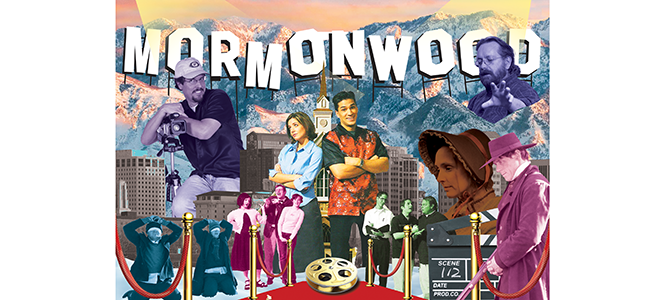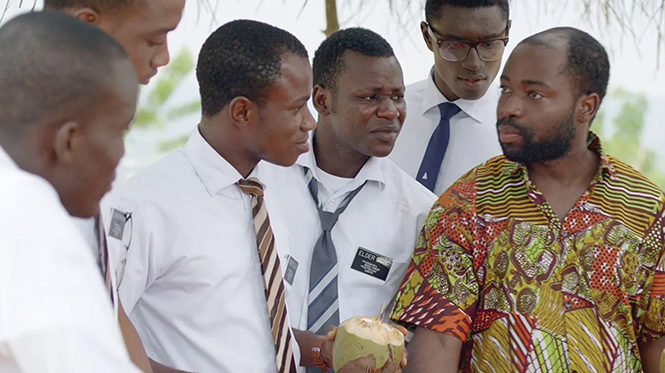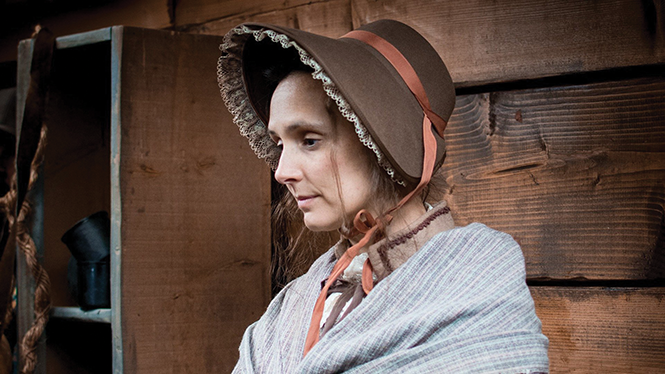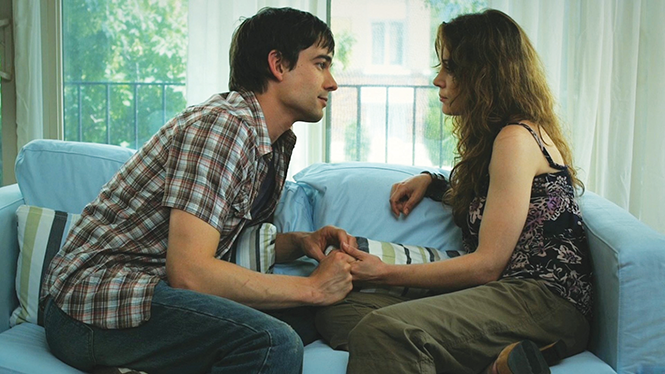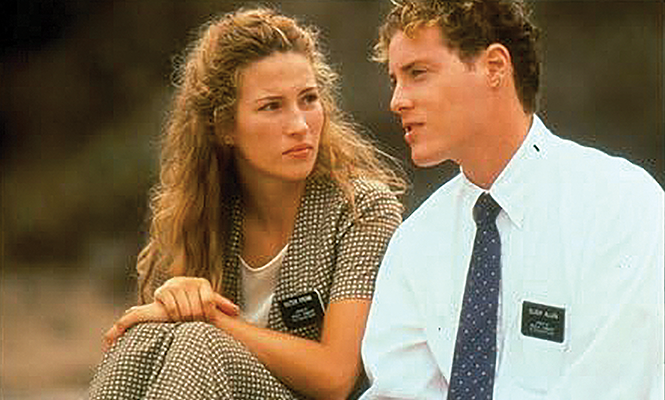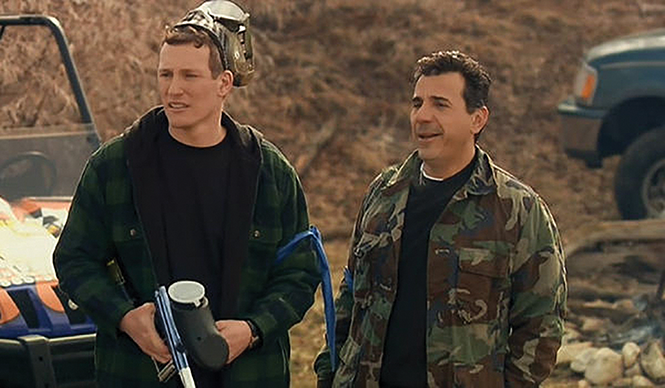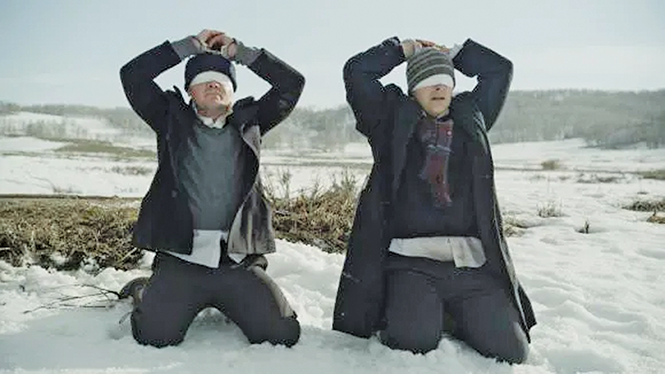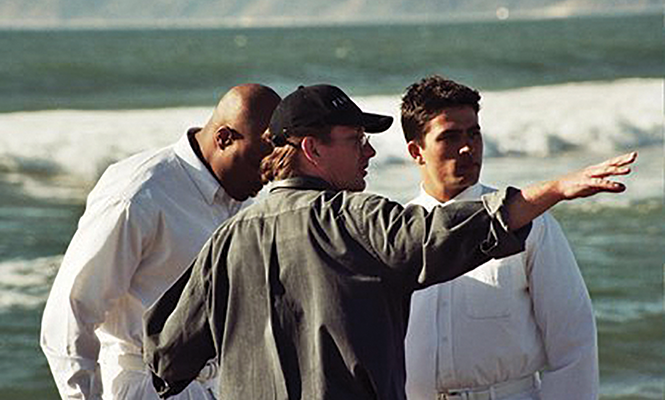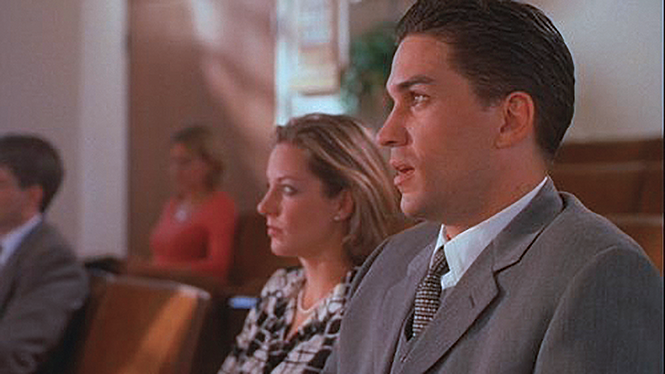And it came to pass that yea, verily, the earth cooled. And then the dinosaurs roamed, and then America was "discovered." And then yes, the colonies broke away from England and lots of other stuff, and then The Church of Jesus Christ of Latter-day Saints began in 1830. And then yes, lots of other stuff, and then ... Mormon cinema dawned in the year of our Lord 2000.
Sounds dramatic, no? Well, that's almost as dramatic as the LDS faithful and budding LDS filmmakers saw Mormon cinema when the first LDS-Christian stories began showing up at the same movie houses where Latter-day Saints watched standard Hollywood fare.
If someone were to ask me how I know this, I'd reply with over-the-top drama: "I was there!" I was living in Los Angeles at the time, one of many hopefuls seeking fame and fortune with movie star and screenwriter dreams.
Like many of us in the Los Angeles First Ward (a "singles ward" or young adult congregation), I was inspired by Richard Dutcher's film God's Army (2000).
Yet to call us "inspired" is akin to saying Leonardo da Vinci was a guy who could draw well. Every LDS ward—especially in Los Angeles—was buzzing about it.
Richard Dutcher had a vision in the late 1990s that LDS stories could find a cinematic home, just as those of Queer and African-American cinema had achieved during the previous decade. After evangelizing this vision for roughly the same amount of time, a young LDS elder serves a mission, he realized it in the form of his marquee drama, the story of a Mormon missionary in Los Angeles.
Think of it as a spiritual version of what Charlie Sheen's character endured in Platoon (1986), only funnier. What followed was such a surge of LDS-themed movies in such a short amount of time that—as a comedian at the time—I thought it was ripe for parody in my own film The Work and The Story, which was released in 2003.
Because it's been 20 years since my movie reached Northern Utah cinemas, I wanted to look at this fun, exhilarating and strange moment in Latter-day Saint cultural history—its beginnings, its behind-the-scenes drama of the middling years and its evolution since then. To do this, I interviewed four filmmakers who were also there: Garret Batty (The Saratov Approach, 2013; Freetown, 2015; Out of Liberty, 2019), John Moyer (The Singles Ward, 2002; Mobsters & Mormons, 2004), Daryn Tufts (My Girlfriend's Boyfriend, 2010; We Love You, Sally Carmichael, 2017) and Richard Dutcher (God's Army, 2000; States of Grace, 2005).
In the Beginning
Did the Mormon cinema era occur due to a movie that just happened to break out for an LDS audience? Dutcher says it was no accident.
"It was absolutely intentional," he said. "And I had zero doubts that it was gonna take off."
For the Latter-Day Saint Christian faithful, it was a pleasant surprise to see a movie in theaters telling a decidedly LDS story. To budding LDS filmmakers, it was an absolute revelation.
"I remember seeing a poster for God's Army hanging up in Jordan Commons," recalls Daryn Tufts (My Girlfriend's Boyfriend). "I was shocked to see a movie poster with LDS missionaries on it. It was shocking to see that in the real world. And then I found out it wasn't a studio film. It was an independent movie that somebody made. And so I knew I wanted to find out more about it and try to support it."
Garrett Batty (The Saratov Approach) also remembered the moment well. "Richard Dutcher's God's Army ... helped me make the realization that for the right budget and the right tone of film, these [movies] could do very well."
What attracted Batty to LDS cinema was not a love of cinema and lifelong dream to direct and make his own films. What drew him specifically to LDS Christian cinema was that "within this genre," he said, "we had a very active and receptive audience and sort of the full resources for writing, producing, directing and releasing films that could be profitable."
Dutcher remembers when the vision that led to God's Army struck him. He had been living in Los Angeles and one day, on his apartment's little patio—barbecuing hamburgers on a small grill as he read the Los Angeles Times' film reviews—he wondered, why can't Mormons have their own films?
Dutcher said he recalled an article he had read in which former LDS church leader Spencer W. Kimball asked of Mormonism: Where are our Shakespeares?"
"It's like every other community has their own films. And it just hit me like a freight train," Dutcher said. "And then my mind just started clicking."
Richard Dutcher was Mormon cinema's Joseph Smith and Steven Spielberg all rolled into one, and we—those interested in a career in film—were his apostles, whether or not any of us would have characterized it that way at the time.
To us, we were not only chasing our dreams. As Dutcher stated, we were fulfilling President Kimball's prophecy and petition that we as a people have our Shakespeares and Tolstoys, our Truffauts and Tarkovskys—artists who could tell our stories truthfully.
In the Middling ...
The stories about the making of the films that flooded this brand new LDS movie market were great stories unto themselves, and their cultural reaction only underscored how many different "types" of Mormons there always have been. The challenge of finding money and the pain of independent filmmaking is common to every filmmaker—Mormon or not—including my experience making my own movie, the first Mormon "mockumentary" (cue the momentous-sounding French horns).
And it makes sense that once a movement gets big enough, the personalities involved can also get big enough that conflict and drama is inevitable.
I'd been trying to break into comedy in LA since 1998. It took more than a year for the seed of Dutcher's film to blossom in my head as the notion to make my own film, but I found myself thinking about what story I could tell.
One day, when visiting a self-important acquaintance I'd known at the University of Utah on the set of his low-budget vampire film, I was struck by how many people were helping with his "vision." He kept using the word "vision," and his small gaggle of volunteers with a beatific, cultish gleam in their eyes also kept talking about his "vision." I tried not to laugh in his face. It wasn't easy.
Suddenly, the main character of my movie (Peter, who I play) was forming in my head. I knew I could make my own Spinal Tap or Waiting for Guffman, but focused on LDS filmmakers. Soon, I had my own vision (there's that word again) that I could spoof small town, small-budget filmmaking by way of Mormon cinema and poke fun at LDS self-seriousness through a comedic faux-documentary, a la The Office.
I wrote the screenplay, but I would say what ended up on film was half of what I wrote. The other half was donated by the funniest guys in Utah (Quinton Casperson, Scott Christopher, Kirby Heybourne, Christopher R. Miller, Andrew Munoz and even Dutcher himself, to name a few).
I cold called Dutcher and introduced myself. He was pleasant and accessible, but it took a while to convince him to play himself in my movie, as he shot down every idea I had for the main plot.
Finally, after weeks, I sat down in his office, and said with resigned numbness, "Maybe you'll hate this one, too, but what if you're missing and presumed dead, and there's a race to replace you as the next 'Mormon Spielberg.'"
Dutcher gave a reserved smile. He liked it.
Production wasn't absolutely smooth sailing (is it ever?), but the critics loved Richard's willingness to have fun with the genre/movement, and his place in it.
Some gave me advice that I go straight to video, but I discounted it, because in my mind, an LDS film goes to theaters—period. Sadly, I found out too late that making Mormon cinema's first mockumentary was not the most lucrative of choices.
I started to get the sinking feeling at the premiere that despite all my efforts, despite the debt I was in, this movie would underperform. And underperform it did. It opened on five screens in Utah with a box office gross of $2,200. I was crushed.
The Arizona critics (in 2004) liked my movie a lot more than the Utah critics. At least Scott Renshaw at City Weekly gave it 2.5 out of 4 stars (thank you again, Scott). And Eric D. Snider of the Provo Herald referred to my movie's egg scene as "nearly genius." It gained a small cult following on video.
Off-screen Drama
I had called Richard Dutcher out on some of his words and actions between 2003 and 2006, assuming we had become friends since he'd been in my movie. I was wrong, so I backed off. Luckily, we buried the proverbial hatchet (and AR-15s) a few years later.
However, the biggest drama in my opinion was between the person who created the first successful Mormon drama vs. those who created the first successful Mormon romantic comedy.
Because Dutcher had started this movement of popular LDS movies shown theatrically, Kurt Hale (director of The Singles Ward) had asked Dutcher to give his crew feedback not only on the script, but on the rough cut of the film as well. "I took it seriously," Dutcher said, "writing all these notes."
Dutcher said he flagged a number of potential problems he saw and suggested a few days of reshooting for the benefit of the film. When he watched the finished film later, none of his advice had been heeded.
Dutcher was angry and spoke to the film's producer, asking why the team had ignored his advice. The man's response, Dutcher said, is burned into his brain.
"I would swear before God that he said this—he said, 'Richard, we could crap on a paper plate, and the audience would eat it up.'" Dutcher said. "And I was so offended by that ... my jaw just hit the floor."
When the movie made money, Dutcher had at first kept his true feelings about the general quality of Singles Ward to himself. But after his interaction with the producer, he "let loose," posting a review of Singles Ward to an email group of roughly 60 people and tearing the movie apart.
"I made forever enemies. I was persona non grata to them," Dutcher said. "It was so bad that, years later, I tried to apologize. I said, 'I meant all those things, but I apologized for the way I said them.' And he was just not having it at all."
Dutcher emphasized that today, he has zero hard feelings toward any of the Mormon filmmakers.
"We were all younger, and we were trying to figure things out," he said. "I don't want to come across as angry or stir up old animosities that shouldn't have happened in the first place ... I have no bitterness toward any of that anymore. I have a little bit of bitterness about what happened to Mormon cinema—because it was so important to me, you know?—but yeah."
Singles Ward writer John Moyer said recently that the film's producer caught wind (through these interviews) that Dutcher had no hard feelings. He said the producer wanted to make it clear that "they gladly accept his apology." Good to know that now, all is settled.
But there were other types of drama, according to Moyer, like one incident publicly shared by the producer of Singles Ward and other LDS films in which an investor called up irate after misunderstanding what he read about a film's box office receipts in a national newspaper. "You had a guy calling up [the filmmakers], giving death threats if he doesn't get his money," Moyer said. "Stuff like that."
Not an End, an Evolution ...
Mormon cinema has drastically changed because both Mormons and cinema have drastically changed.
All four of the filmmakers I spoke to mentioned the differences in how LDS films are both perceived and the forms they currently take. Some are more broadly faith-based, while some are specific to the LDS faith. Some go to theaters, most don't. Some are about LDS people, some aren't stories of LDS Christians at all—they're simply stories that LDS filmmakers want to tell. And, as Moyer said, "we're also competing with 14-year-olds making Tik Tok videos."
As the entire film industry has changed in the past 20 years to this digital Brave New World, where grabbing eyeballs is the lifeblood of both Hollywood and Big Tech, so too have the sensibilities behind Mormon eyeballs.
"It's a different church now," Moyer said.
And he's right—the church and its culture are different. Church membership has declined, and even those who have clung tightly (and culturally) to the iron rod of the LDS faith are not homogenized.
Some Mormons have become more secular (30% openly admit to drinking coffee, something unheard of 20 or 30 years ago), while some faithful members have circled their wagons even tighter against Hollywood films and the perceived evils of the world.
And all along, the filmmakers have changed. Of the four interviewed, two—Batty and Tufts—still actively participate in the church, but all shared similar views of the status of Mormon cinema.
Garrett Batty unapologetically continues to make LDS "faith-based" films, believing that the demand for these films will increase once more. Tufts sees it as a spectrum, believing the sub-genre has simply (and complexly) evolved. "It never left," Tufts says.
John Moyer remarked on the fickle nature of the LDS audience: the claims of what they want despite the reality of where they spend their entertainment money. Meanwhile, Dutcher himself laments the promise of what Mormon cinema might have been: An LDS dramatic arts renaissance wherein LDS films would push boundaries to explore Latter-day Saint lives, doctrines, histories and meanings, with the faithful lauding said artistic exploration.
Asked what he thought about Tufts' assertion that LDS cinema hasn't disappeared, Dutcher questioned where these supposed films are that deeply investigate the Latter-day Saint experience.
"Show me a movie from the Mormon community that delves deeply into faith, and I'd be happy to agree," Dutcher said. "But I haven't seen it."
And yet, perhaps the most glaring evidence to the assertion that LDS cinema has indeed evolved in complex ways lies in Dutcher's current film project—the true story of an LDS missionary who converts to evangelical Christianity while on his mission. In Dutcher's mind, the movie (called Jesus Is Enough) puts him back on track to exploring faith through film.
"This is the first time since God's Army that I've had a project that I just got the same feeling where it's like: This is gonna work," he said.
Dutcher acknowledged that the movie likely will be very controversial to LDS audiences. When asked about the faithful Latter-day Saints inspired by films like God's Army, Dutcher said he hoped they'd recognize that he's still asking the hard questions.
"They may think I'm off on the wrong track, but God is still the most important thing to me," Dutcher said. "God and movies are still the most important thing."
And when Richard said that he no longer has any "bitter" feelings toward his peer Mormon filmmakers like he did back in the day, it became clear that he also holds no bitter feelings toward Mormonism itself.
"It made me who I am," Dutcher said.
Nathan Smith Jones is a doctor of media and education. A long time secondary English teacher, he also teaches at Utah Valley University and Salt Lake Community College. He has spent many years writing and producing films, novels and novellas. Find Jones' work, including additional excerpts from his interviews with LDS Christian filmmakers, at nathansmithjones.com/lds
Latest in Cover Story
Readers also liked…
-
Forget the family pedigree—Robert F. Kennedy Jr should not be the next president of the United States
Trojan Horse
- Jun 21, 2023
-
Women decry harassment and toxic culture at St. George auto dealership
Men at Work
- Oct 11, 2023


